Fourteenth International Conference on Computational Methods and Experimental Measurements
Algarve, Portugal
Overview & Opening Address
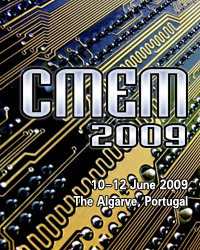 The 14th International Conference on Computational Methods and Experimental Measurements was held recently in the Algarve, Portugal, co-chaired by Professor G. Carlomagno of the University of Naples and Professor Carlos Brebbia, Director of the Wessex Institute of Technology (WIT).
The 14th International Conference on Computational Methods and Experimental Measurements was held recently in the Algarve, Portugal, co-chaired by Professor G. Carlomagno of the University of Naples and Professor Carlos Brebbia, Director of the Wessex Institute of Technology (WIT).This series of conferences started in 1981 in Washington DC and since then has been reconvened every two years in different locations with uninterrupted success. The main objective of the meeting is to provide to the international technical and scientific community a forum to discuss the interaction and complementary aspects of computational methods and experimental measurements, the main consideration and importance being committed to their advantageous integration.
It is well known that the continuous progress in computer efficiency and numerical techniques are producing a steady growth of computational simulation which nowadays influences an ever-widening range of engineering problems, as well as our everyday activities. As these simulations are continuously expanding and improving, there still exists the necessity of their validation, which can be easily accomplished by performing dedicated experimental tests. Furthermore, because of their incessant development, experimental techniques are becoming more complex and sophisticated so that, both their running as well as data collection can only be performed by means of computers. Finally, it must be stressed that, for the majority of measurements, the obtained data must be processed by means of numerical methods.
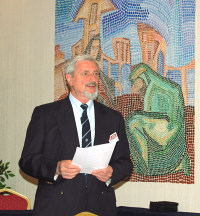 Carlos started the proceedings by welcoming the participants to CMEM/09 and explaining the objectives of WIT and the importance the Institute attributes to the conference series. The meetings are a source of collaborative projects built around multidisciplinary teams. The conferences help to bring all these teams together, as well as providing a powerful mechanism for knowledge transfer.
Carlos started the proceedings by welcoming the participants to CMEM/09 and explaining the objectives of WIT and the importance the Institute attributes to the conference series. The meetings are a source of collaborative projects built around multidisciplinary teams. The conferences help to bring all these teams together, as well as providing a powerful mechanism for knowledge transfer.Carlos explained the importance of being able to communicate across different disciplines in order to find solutions relevant to the current problems of society. The work of WIT, although highly specialised in the field of computer modelling, can be seen as contributing to the solution of many important environmental and ecological problems.
WIT also collaborates with the engineering industry through its software applications which are based on the Boundary Element Method, a flagship development associated with the name of Wessex Institute. The wide spread of the method in industry is also an important part of WIT’s objectives.
Finally, Carlos referred to the many advances recently made by WIT Press in the field of publishing. He mentioned in particular the distribution of books, including printing in digital form, which contribute to the dissemination of the material presented at WIT conferences, including CMEM.
Keynote Address
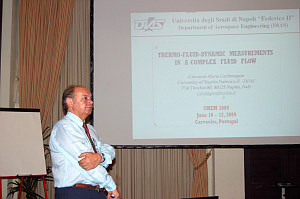 Carlos next introduced Giovanni Carlomagno, Professor of Gas Dynamics at the University of Naples and a distinguished and well known scientist. He has served with distinction at his University where he has been a Member of the Board of Trustees, Dean of the Mechanical Engineering School and of the Aerospace Engineering School. He has received the Leonardo da Vinci award for Flow Visualisation, the Journal of Visualisation Award and has been made a Fellow of the Japan Society for the promotion of Science, among other distinctions. He is author of some 300 scientific papers, editor or co-editor of some 20 books and member of the Editorial Board of more than 10 international scientific journals. Giovanni is Co-Chairman of the CMEM Conference and in 1999 received the Eminent Scientist Medal of Wessex Institute, having collaborated with WIT in a series of important initiatives.
Carlos next introduced Giovanni Carlomagno, Professor of Gas Dynamics at the University of Naples and a distinguished and well known scientist. He has served with distinction at his University where he has been a Member of the Board of Trustees, Dean of the Mechanical Engineering School and of the Aerospace Engineering School. He has received the Leonardo da Vinci award for Flow Visualisation, the Journal of Visualisation Award and has been made a Fellow of the Japan Society for the promotion of Science, among other distinctions. He is author of some 300 scientific papers, editor or co-editor of some 20 books and member of the Editorial Board of more than 10 international scientific journals. Giovanni is Co-Chairman of the CMEM Conference and in 1999 received the Eminent Scientist Medal of Wessex Institute, having collaborated with WIT in a series of important initiatives. Professor Carlomagno then proceeded to give a keynote address on the topic of thermo fluid dynamics measurements in complex fluid flow. He referred to the problems involved in carrying out accurate experiments in three dimensions and how the results can be improved by using preliminary estimates and applying data validation criteria. The process requires a considerable amount of computational work. Giovanni presented a series of interesting examples demonstrating the accuracy of the proposed methodology which combines excellent experimental work with intensive computations.
Other keynote and invited addresses were:
- “Heat and moisture transport in porous materials involving cyclic wetting and drying” by R. Cerny, Czech Technical University of Prague.
- “Non-thermal, chemical destruction of PCB from Sydney tar ponds soil extract” by A.J. Britten, Cape Breton University, Canada.
- “Multi-scale FE analyses of sheet formability based on SEM-EBSD crystal texture measurement” by H. Sakamoto, Kumamoto University, Japan.
- “A versatile software-hardware system for environmental data acquisition and transmission” by G. Zappala, CNR Institute for Marine Coastal Environment of Messina, Italy.
- “On the differences of transitional separated-reattached flows over leading-edge obstacles of varying geometries” by I.E. Abdalla, De Montfort University, UK.
- “Natural and mixed convection in inclined channels with partial openings” by A. Andreozzi, University of Naples, Italy.
- “Direct simulation of sounds generated by collision between water drop and water surface” by M. Tsutahara, Kobe University, Japan.
- “Finding the “optimal” size and location of treatment plants” by J.E. Everett, The University of Western Australia.
Conference Sessions
The Conference attracted a substantial number of excellent scientific papers in which advanced approaches to modern research problems were presented. They were grouped in the following sections: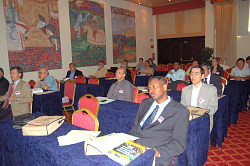 Computational and experimental methods
Computational and experimental methods- Experimental and computational analysis
- Direct, indirect and in-situ measurements
- Detection and signal processing
- Data processing
- Fluid flow
- Heat transfer and thermal processes
- Material characterisation
- Structural and stress analysis
- Industrial applications
- Forest fires
Special Session
- “Antenna radiation patterns indication on the basic measurement of field radiation in the near zone” by M. Wnuk
- “Sub-ppb Nox detection by a cavity enhanced absorption spectroscopy system with blue and infrared diode lasers” by Z. Bielecki
- “Multispectral detection circuits in special applications” by W. Kolosowski
- “Length measurements in digital images by using anchored discrete convolution algorithm” by A. Suhadolnik
- “Modification of raised cosine weighting functions family” by A. Kawalec
- “Technique for the electric and magnetic parameter measurement of powdered materials” by R. Kubacki
- “Acoustic watermark server effectiveness” by Z. Piotrowski
- “Intrapulse analysis of radar signal” by Z. Pieniezny
- “Neural detection of parameter changes in a dynamic system using time-frequency transforms” by E. Swiercz
- “National network-centric system and its components in the age of information warfare” by Z. Piotrowski
Conference Dinner
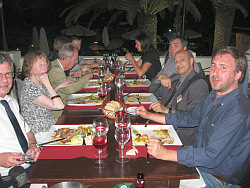 The Conference dinner took place in a restaurant renowned for its Portuguese cuisine. There the participants were able to taste a series of local delicacies, washed down by Duoro’s wines. Following that, a local folkloric group performed Algarve dances. The folklore of this region of Portugal is different from the rest of the country and is characterised by its fast pace and general feeling of joy and happiness. At the end of the performance, some of the participants demonstrated their energy and hidden talent by joining the dancers. At the end of the banquet, Carlos thanked the participants and gave them a gift as a reminder of the Conference. This consisted of a piece of hand-made and hand-decorated pottery. The pieces are made as in the ancient past and the colours are those typical of pottery in this part of Europe, with a predominance of blue, green and yellow. The pottery was set up many years ago by a graduate from Lisbon School of Arts, who wanted to produce pieces based on ancient traditions. Unfortunately, the number of authentic ceramic workshops continue to decrease in the south of Europe, emphasising the importance of supporting the remaining ones so as to retain these ancient skills.
The Conference dinner took place in a restaurant renowned for its Portuguese cuisine. There the participants were able to taste a series of local delicacies, washed down by Duoro’s wines. Following that, a local folkloric group performed Algarve dances. The folklore of this region of Portugal is different from the rest of the country and is characterised by its fast pace and general feeling of joy and happiness. At the end of the performance, some of the participants demonstrated their energy and hidden talent by joining the dancers. At the end of the banquet, Carlos thanked the participants and gave them a gift as a reminder of the Conference. This consisted of a piece of hand-made and hand-decorated pottery. The pieces are made as in the ancient past and the colours are those typical of pottery in this part of Europe, with a predominance of blue, green and yellow. The pottery was set up many years ago by a graduate from Lisbon School of Arts, who wanted to produce pieces based on ancient traditions. Unfortunately, the number of authentic ceramic workshops continue to decrease in the south of Europe, emphasising the importance of supporting the remaining ones so as to retain these ancient skills.
International Scientific Advisory Committee Meeting
The International Scientific Advisory Committee (ISAC) meeting held over dinner decided to reconvene the Meeting in 2011. Different locations were discussed and the WIT Conference Division will investigate several of them. The objectives of the Conference will be broadened, based on the experience of the 2009 meeting and a few more colleagues will be invited to join the ISAC.
Publication of Papers
 The proceedings of “Computational Methods and Experimental Measurements XIV” 672pp (Print ISBN: 1-84564-187-0; On-line ISBN: 1-84564-364-5; Print ISSN: 1746-4064) are available from WIT Press priced at £255/US$459/€329. Orders can be placed by telephone: +44 (0) 238 029 3223, fax: +44 (0) 238 029 2853, e-mail: This email address is being protected from spambots. You need JavaScript enabled to view it. or via the WIT Press web site at www.witpress.com.
The proceedings of “Computational Methods and Experimental Measurements XIV” 672pp (Print ISBN: 1-84564-187-0; On-line ISBN: 1-84564-364-5; Print ISSN: 1746-4064) are available from WIT Press priced at £255/US$459/€329. Orders can be placed by telephone: +44 (0) 238 029 3223, fax: +44 (0) 238 029 2853, e-mail: This email address is being protected from spambots. You need JavaScript enabled to view it. or via the WIT Press web site at www.witpress.com.Papers from the conference will also be hosted online at the WIT eLibrary as volume 48 of WIT Transactions on Modelling and Simulation (On-line ISSN: 1743-355X). For more details visit the WIT eLibrary at www.witpress.com.


 Wessex Institute
Wessex Institute